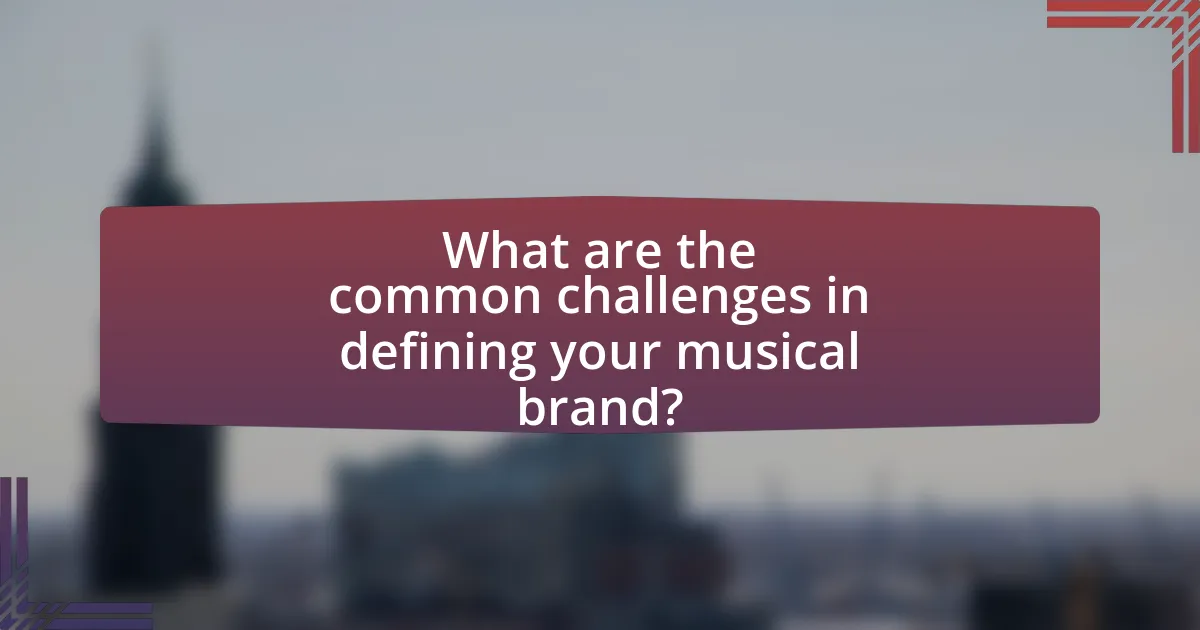The article focuses on the process of crafting a unique sound and defining a musical brand for artists. It outlines the importance of developing a distinctive musical identity that sets an artist apart in a competitive industry, emphasizing the role of musical influences, experimentation, and skill development. Key sections discuss identifying influences, analyzing genres, the significance of a strong musical brand, and strategies for effective communication with audiences through visuals and social media. Additionally, it addresses common challenges artists face in brand definition and offers practical tips for refining their sound and maintaining authenticity.

What does it mean to craft your unique sound in music?
Crafting your unique sound in music means developing a distinctive musical identity that sets an artist apart from others. This process involves blending various musical influences, techniques, and personal experiences to create a signature style that resonates with listeners. For example, artists like Billie Eilish have successfully crafted their unique sound by combining elements of pop, electronic, and alternative music, which has contributed to their widespread recognition and appeal. This distinctiveness is crucial in a saturated music industry, as it helps artists establish a recognizable brand and connect with their audience on a deeper level.
How can you identify your musical influences?
To identify your musical influences, actively listen to a diverse range of music and analyze the elements that resonate with you. This involves paying attention to specific genres, artists, and songs that evoke strong emotional responses or inspire your creativity. Research indicates that exposure to various musical styles can shape an individual’s artistic identity, as seen in studies highlighting the impact of genre familiarity on musical preferences (North & Hargreaves, 2008). By reflecting on your personal music library and the artists you admire, you can pinpoint recurring themes, instrumentation, and lyrical styles that contribute to your unique sound.
What role do your favorite artists play in shaping your sound?
Favorite artists significantly influence the development of my sound by providing inspiration and a framework for creativity. Their unique styles, techniques, and emotional expressions serve as a reference point, guiding my musical choices and experimentation. For instance, studying the chord progressions and lyrical themes of artists like Joni Mitchell or Radiohead has led me to incorporate similar elements into my own compositions, enhancing my songwriting skills. This influence is evident in the way I blend genres, drawing from the diverse sounds of my favorite musicians, which ultimately helps define my musical identity.
How can you analyze the elements of your favorite genres?
To analyze the elements of your favorite genres, identify key characteristics such as instrumentation, rhythm, melody, harmony, and lyrical themes. For example, in rock music, electric guitars and strong backbeats are prevalent, while in jazz, improvisation and complex chord progressions are essential. By examining these elements, you can understand how they contribute to the overall sound and emotional impact of the genre. This method allows for a deeper appreciation and can inform your own musical creations, aligning them with the stylistic features you admire.
Why is defining your musical brand important?
Defining your musical brand is important because it establishes your identity in the music industry, differentiating you from other artists. A clear musical brand helps to communicate your unique style, values, and message to your audience, which can lead to stronger fan engagement and loyalty. According to a study by the Berklee College of Music, artists with a well-defined brand are more likely to attract and retain listeners, as they create a consistent and recognizable presence across various platforms. This consistency not only enhances visibility but also increases opportunities for collaboration and marketing, ultimately contributing to an artist’s long-term success.
How does a strong musical brand impact your career?
A strong musical brand significantly enhances a musician’s career by establishing a distinct identity that resonates with audiences and industry professionals. This identity helps in attracting a loyal fan base, which is crucial for sustained success in the competitive music landscape. For instance, artists like Taylor Swift and Beyoncé have cultivated strong brands that not only reflect their musical styles but also their personal values, leading to increased sales, concert attendance, and media visibility. According to a study by the Berklee College of Music, musicians with a well-defined brand are 60% more likely to secure lucrative partnerships and sponsorships, demonstrating the tangible benefits of a strong musical brand on career advancement.
What are the risks of not having a defined musical brand?
Not having a defined musical brand can lead to a lack of audience recognition and engagement. Without a clear identity, musicians struggle to differentiate themselves in a saturated market, resulting in diminished visibility and potential fanbase growth. Research indicates that artists with a strong brand presence are 30% more likely to attract and retain listeners, as they create a memorable connection through consistent messaging and imagery. Additionally, the absence of a defined brand can hinder opportunities for collaborations and partnerships, as industry professionals often seek artists with a recognizable and cohesive image.
What steps are involved in crafting your unique sound?
Crafting your unique sound involves several key steps: identifying your influences, experimenting with different styles, developing your skills, and refining your sound through feedback. First, identifying your influences helps you understand the genres and artists that resonate with you, providing a foundation for your musical identity. Next, experimenting with various styles allows you to explore different techniques and sounds, which can lead to discovering what truly represents you. Developing your skills through practice and education enhances your ability to express your ideas musically. Finally, refining your sound by seeking feedback from peers and audiences helps you to make adjustments and improvements, ensuring that your unique sound evolves and resonates with listeners.
How can experimentation lead to a unique sound?
Experimentation can lead to a unique sound by allowing artists to explore unconventional techniques, instruments, and genres, which can result in innovative musical expressions. When musicians step outside traditional boundaries, they often discover new combinations of sounds and styles that differentiate their work from others. For instance, artists like Björk and Radiohead have utilized experimental approaches, such as incorporating electronic elements and non-standard song structures, to create distinctive sonic identities. This process of experimentation not only fosters creativity but also encourages the development of a personal musical language that resonates with listeners, ultimately shaping an artist’s brand in the music industry.
What tools and techniques can help in sound development?
Digital audio workstations (DAWs) are essential tools for sound development, allowing musicians to record, edit, and produce audio. Popular DAWs like Ableton Live, Logic Pro, and Pro Tools provide a range of features such as MIDI sequencing, audio manipulation, and built-in effects that facilitate creative sound design. Additionally, synthesizers and samplers, such as Serum and Kontakt, enable the creation of unique sounds through various synthesis methods and sample manipulation.
Techniques such as layering sounds, using effects like reverb and delay, and applying sound modulation can enhance the richness and depth of the audio. Research indicates that effective sound layering can lead to a more complex and engaging auditory experience, as demonstrated in studies on music production techniques. By utilizing these tools and techniques, musicians can effectively craft their unique sound and define their musical brand.

How do you communicate your musical brand to your audience?
To communicate your musical brand to your audience, you utilize a combination of visual identity, social media engagement, and consistent messaging. Visual identity includes elements like logos, album artwork, and stage presence that reflect your unique style and genre. Social media platforms serve as direct channels to interact with fans, share updates, and showcase your music, allowing for real-time engagement and feedback. Consistent messaging across all platforms reinforces your brand’s values and themes, ensuring that your audience understands your artistic vision. For instance, artists like Billie Eilish effectively use cohesive aesthetics and storytelling in their visuals and online presence to create a strong brand identity that resonates with their audience.
What platforms are best for showcasing your music?
The best platforms for showcasing your music are Spotify, SoundCloud, YouTube, and Bandcamp. Spotify is a leading streaming service with over 500 million users, providing artists with extensive reach and playlist opportunities. SoundCloud allows for direct interaction with listeners and is popular among independent artists, boasting over 76 million tracks. YouTube, with its vast audience of over 2 billion users, enables artists to share music videos and engage with fans through comments and live streams. Bandcamp supports artists by allowing them to sell music directly to fans, fostering a community-oriented approach. These platforms collectively offer diverse ways to reach audiences and promote music effectively.
How can social media enhance your musical brand visibility?
Social media enhances musical brand visibility by providing platforms for artists to share their music, engage with fans, and build a community. Through consistent posting and interaction, musicians can reach wider audiences; for instance, platforms like Instagram and TikTok have algorithms that promote content based on engagement, allowing artists to gain exposure to potential fans. According to a 2021 report by the International Federation of the Phonographic Industry, 70% of music consumers discover new music through social media, highlighting its critical role in brand visibility.
What role does live performance play in brand communication?
Live performance serves as a vital component of brand communication by creating direct, immersive experiences that foster emotional connections between the audience and the brand. These performances allow brands to convey their identity, values, and messages in a dynamic and engaging manner, enhancing audience engagement and loyalty. For instance, a study by the University of Southern California found that live events significantly increase brand recall and positive brand perception, with 70% of attendees reporting a stronger emotional connection to brands after experiencing live performances. This evidence underscores the effectiveness of live performance as a strategic tool in brand communication.
How can visuals and aesthetics support your musical identity?
Visuals and aesthetics can significantly enhance your musical identity by creating a cohesive brand image that resonates with your audience. This alignment between visual elements, such as album artwork, stage design, and promotional materials, and your musical style helps to establish a recognizable persona. For instance, artists like Billie Eilish utilize distinct color palettes and fashion choices that reflect their music’s themes, thereby reinforcing their identity. Research indicates that consistent visual branding can increase audience engagement and loyalty, as it allows fans to connect emotionally with the artist’s narrative.
What are the key elements of a cohesive visual brand?
The key elements of a cohesive visual brand include a consistent color palette, uniform typography, a recognizable logo, and a defined imagery style. A consistent color palette ensures that all visual materials evoke the same emotional response and brand identity, while uniform typography maintains readability and reinforces brand recognition across various platforms. A recognizable logo serves as the cornerstone of brand identity, making it easier for audiences to identify the brand quickly. Additionally, a defined imagery style, including photography and graphics, creates a unified look that aligns with the brand’s message and values. These elements work together to create a strong, cohesive visual presence that enhances brand recall and loyalty.
How can album artwork reflect your musical style?
Album artwork can reflect your musical style by visually embodying the themes, emotions, and aesthetics present in your music. For instance, a heavy metal album may feature dark, aggressive imagery, while a folk album might showcase natural landscapes and warm colors, aligning with the acoustic and organic sound. This visual representation serves as a first impression, influencing listener expectations and engagement. Research indicates that cohesive branding, including album artwork, can enhance audience connection and recognition, as seen in the consistent visual themes of artists like Taylor Swift and The Weeknd, which align closely with their musical evolution and style.

What are the common challenges in defining your musical brand?
Common challenges in defining a musical brand include lack of clarity in artistic vision, difficulty in identifying target audience, and inconsistency in messaging across platforms. Artists often struggle to articulate their unique sound and style, which can lead to confusion among listeners. Additionally, pinpointing the right audience is crucial; without understanding who resonates with their music, artists may fail to connect effectively. Inconsistency in branding, such as varying visuals or messaging on social media, can dilute an artist’s identity, making it harder for fans to engage. These challenges highlight the importance of a cohesive and well-defined musical brand for successful audience engagement and market presence.
How can you overcome creative blocks in sound development?
To overcome creative blocks in sound development, engage in structured brainstorming techniques such as mind mapping or free association. These methods stimulate new ideas by allowing you to explore connections between concepts without judgment. Research indicates that engaging in diverse activities, such as listening to different genres or collaborating with other musicians, can also enhance creativity by exposing you to new perspectives and techniques. For instance, a study published in the Journal of Creative Behavior found that varied experiences significantly boost creative problem-solving abilities.
What strategies can help you stay motivated and inspired?
To stay motivated and inspired, set clear, achievable goals that align with your musical aspirations. Research indicates that goal-setting enhances motivation by providing direction and a sense of purpose (Locke & Latham, 2002). Additionally, surrounding yourself with a supportive community of fellow musicians fosters inspiration through collaboration and shared experiences. Engaging in regular practice and exploring new musical styles can also reignite passion and creativity, as studies show that variety in practice enhances skill development and keeps motivation high (Ericsson et al., 1993).
How can collaboration with other artists enhance your sound?
Collaboration with other artists can enhance your sound by introducing new perspectives, techniques, and influences that diversify your musical style. When artists work together, they often blend their unique skills and experiences, resulting in innovative compositions that may not have emerged in isolation. For example, a study by the University of Southern California found that collaborative projects often lead to higher creativity levels and more complex musical arrangements, as artists challenge each other’s ideas and push creative boundaries. This synergy can result in a richer, more textured sound that resonates with a broader audience.
What pitfalls should you avoid when establishing your brand?
When establishing your brand, avoid the pitfall of lacking a clear identity. A well-defined brand identity is crucial, as it helps differentiate your music in a saturated market. Research indicates that brands with a strong identity can achieve up to 20% more customer loyalty compared to those without one. Additionally, neglecting audience engagement can hinder brand growth; brands that actively interact with their audience see a 50% increase in engagement rates. Lastly, inconsistent messaging across platforms can confuse potential fans, leading to a 30% drop in brand recognition.
How can you ensure authenticity in your musical expression?
To ensure authenticity in your musical expression, focus on creating music that reflects your personal experiences and emotions. Authenticity stems from genuine self-expression, which can be achieved by drawing inspiration from your life, culture, and influences. For instance, artists like Billie Eilish have gained recognition for their unique sound and relatable lyrics, which resonate with their personal narratives. This connection between personal experience and musical output fosters a sense of authenticity that audiences can recognize and appreciate.
What are the dangers of following trends too closely?
Following trends too closely can lead to a lack of originality and authenticity in one’s musical brand. When artists prioritize current trends over their unique sound, they risk becoming indistinguishable from others, which can dilute their identity and alienate their audience. Research indicates that artists who maintain a distinct style are more likely to achieve long-term success, as they cultivate a loyal fan base that appreciates their individuality. For instance, a study published in the Journal of Cultural Economics found that musicians who innovate rather than conform to trends tend to have higher sales and greater longevity in their careers.
What practical tips can help you refine your musical brand?
To refine your musical brand, focus on defining your unique sound and consistently communicating it across all platforms. Start by identifying your musical influences and core values, which will help shape your artistic identity. Utilize social media to engage with your audience, sharing behind-the-scenes content and personal stories that resonate with your brand. Additionally, collaborate with other artists to expand your reach and diversify your sound, while ensuring that these collaborations align with your brand’s essence. Regularly assess your brand’s visual elements, such as logos and promotional materials, to maintain a cohesive aesthetic that reflects your musical style. Finally, gather feedback from your audience and industry professionals to make informed adjustments that enhance your brand’s appeal.
How can regular feedback from peers improve your sound?
Regular feedback from peers can significantly enhance your sound by providing diverse perspectives and constructive criticism. This input allows musicians to identify strengths and weaknesses in their work, leading to more refined and polished performances. For instance, studies show that musicians who engage in peer review processes often experience accelerated growth in their skills and creativity, as they are exposed to different styles and techniques. This collaborative environment fosters innovation and encourages artists to experiment, ultimately contributing to a more distinctive musical identity.
What role does continuous learning play in sound development?
Continuous learning is essential in sound development as it enables musicians to adapt, innovate, and refine their artistic expression. By engaging in ongoing education, artists can explore new techniques, understand evolving music trends, and enhance their technical skills, which directly influences their unique sound. Research indicates that musicians who commit to lifelong learning often experience greater creativity and versatility in their work, as evidenced by studies showing that diverse musical influences contribute to a richer sound palette. This adaptability not only helps in personal growth but also in establishing a distinctive musical brand that resonates with audiences.





